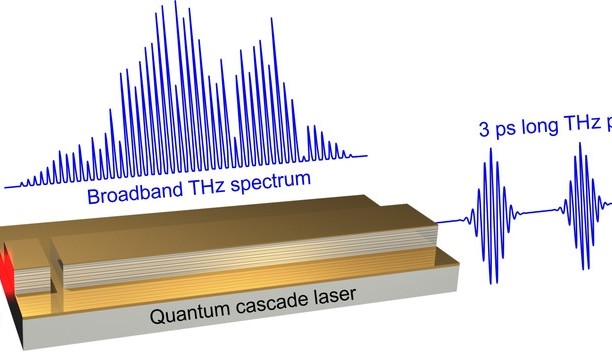Ultra-short terahertz pulses
March 01, 2017
on
on

Researchers at the Technical University Vienna have succeeded in generating ultra-short terahertz light pulses, which are eminently suitable for spectroscopic research and for exceedingly accurate frequency measurements.
Because of its unique characteristics, terahertz radiation is very interesting for a large number of applications, including non-invasive imaging for medical diagnostics. Terahertz waves can penetrate many materials that are opaque to normal light. And at least as important is that, in contrast to x-rays, they are not harmful to living tissue. In addition, many materials have a molecular 'fingerprint' in the terahertz range so that they can be discovered spectroscopically.
Terahertz waves can be generated in an efficient manner using a quantum scale laser. These lasers consist of an accurately defined series of multiple hundreds of layers of semiconductor material each of which are only a few nanometers thick. This way it becomes possible to arbitrarily choose the energy levels of the electrons in the semiconductor structure. As a result the frequency of the radiated laser light can be customized to suit the application.
An until recently unsolved problem with quantum cascade lasers was the generation of laser lines (frequencies) with different propagation speeds. This phenomenon is caused by lateral laser modes of a higher order. As a consequence the usable bandwidth is greatly reduced. The researchers have now succeeded in completely suppressing these modes by introducing absorbent material to the sides of the laser resonator, without influencing the fundamental laser mode to any significant extent. This makes an emission bandwidth of more than an entire octave possible, as well the the generation of laser pulses with a duration of less than 3 picoseconds.
Because of its unique characteristics, terahertz radiation is very interesting for a large number of applications, including non-invasive imaging for medical diagnostics. Terahertz waves can penetrate many materials that are opaque to normal light. And at least as important is that, in contrast to x-rays, they are not harmful to living tissue. In addition, many materials have a molecular 'fingerprint' in the terahertz range so that they can be discovered spectroscopically.
Terahertz waves can be generated in an efficient manner using a quantum scale laser. These lasers consist of an accurately defined series of multiple hundreds of layers of semiconductor material each of which are only a few nanometers thick. This way it becomes possible to arbitrarily choose the energy levels of the electrons in the semiconductor structure. As a result the frequency of the radiated laser light can be customized to suit the application.
An until recently unsolved problem with quantum cascade lasers was the generation of laser lines (frequencies) with different propagation speeds. This phenomenon is caused by lateral laser modes of a higher order. As a consequence the usable bandwidth is greatly reduced. The researchers have now succeeded in completely suppressing these modes by introducing absorbent material to the sides of the laser resonator, without influencing the fundamental laser mode to any significant extent. This makes an emission bandwidth of more than an entire octave possible, as well the the generation of laser pulses with a duration of less than 3 picoseconds.
Read full article
Hide full article


Discussion (0 comments)